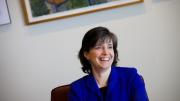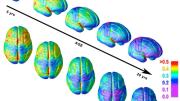Editor’s note: Harvard Management Company (HMC) will report investment results for fiscal year 2009 in mid September (see www.harvardmagazine.com and the November-December issue for reports). Given widespread interest in the endowment, the magazine asked HMC president Jane Mendillo to comment now on recent developments. Her response follows.
During the first four months of the fiscal year that began on July 1, 2008—when I joined HMC as CEO—virtually every market underwent sharp losses. Domestic and international equities, emerging markets and commodities—all decreased 25 percent to 45 percent within weeks.
These unprecedented losses, and the continuing extraordinary market conditions, affected Harvard’s endowment—and those of every other major university. We expect that when our audited results are reported in September, we will come close to the 30 percent investment losses the University projected in December. Nonetheless, Harvard’s endowment remains significantly larger than any other university’s, and certainly better off than if we had pursued a more conservative investment strategy.
Indeed, Harvard has enjoyed a 14.6 percent annual average return on endowment investments during the 30-year period ended June 30, 2008, and a return of 13.8 percent annualized during the last 10 years. By comparison, the median fund (from a universe of 151 funds with assets of more than $1 billion) had an average annual return of 6.1 percent during those 10 years.
Managing the Harvard portfolio through the unforeseen and unprecedented market turmoil of the last 12 months has obviously been challenging, but it has also provided us with an opportunity to begin to position HMC and the endowment in new ways.
First, we have critically reviewed our mix of investments and supporting activities, and have adjusted our investment strategies and our organization. This has allowed us to take advantage of the investment windows that we anticipated would emerge when the world economies eventually stabilized. We began immediately to gather the resources to do so.
Second, we moved quickly to “break down the walls” between some of the asset classes within which we traditionally operated. During my 15 years as a senior investment professional at HMC, and subsequently while I managed Wellesley’s endowment, I had seen the power of adding lesser-known strategies, like investing in natural resources, to the mix.
While our long-term goal is to seek substantial growth while managing risk in order to allow the University to spend and maintain the purchasing power of the endowment over time, we have responded to short-term pressure and opportunities with intensity and action.
Building on HMC’s unusual expertise in real-asset investments (timberland, agriculture, and real estate), we have hired an experienced new leader for our real estate team and explored adding new strategies in natural resources. We have added strength and depth to our exceptionally talented team managing fixed-income and equity-arbitrage assets within HMC. We have changed our traditional 5 percent negative allocation to cash to a position that is cash positive. As a result, we are now poised to quickly pursue what will undoubtedly be attractive investment opportunities coming out of these difficult times, while also providing the resources necessary to meet the University’s short-term needs.
HMC continues to pursue its unique hybrid model, employing a mix of internal and external investment-management teams that focus on specific investment arenas, providing depth and breadth to our market perspectives. Our externally managed assets—overseen by a staff of specialists in private equity, real estate, hedge funds, and more liquid public markets—provide us with an unparalleled breadth of expertise and exposure. Our internal team, responsible for investing approximately 30 percent of the assets, is constantly attuned and responsive to changing market conditions, and allows us to be unusually nimble. Internal management is also extremely cost-effective compared to employing outside managers for similar asset pools with similar results.
These best-in-class strategies, coupled with sound portfolio construction and rigorous risk management, will yield long-term results that enable Harvard to pursue its many goals.
Even during this past year, Harvard has performed remarkably well in certain areas: our international fixed-income team, for example, had an extraordinary year. We also earned significant positive returns through active management of our portfolio hedges. And importantly, we have taken action across the portfolio to reduce leverage and increase financial flexibility.
Realistically, it may take many years to regain all of the market value lost as a result of the global economic crisis, but we have ample cause for optimism. While navigating last year’s storm, we have strengthened our investment team and positioned HMC and the Harvard endowment to benefit from the growth that will occur as the economy rebounds.








